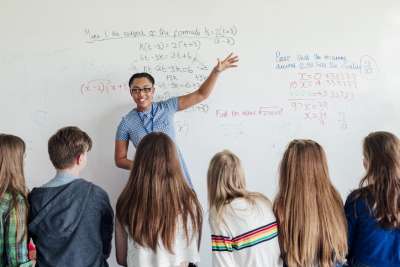Learn how to effectively use fraction strips, spinners, counters, and more
Manipulatives are physical objects that are used as teaching tools to engage students in the hands-on learning of mathematics. They can be used to introduce, practice, or remediate a concept. Use this resource to help your students learn how to use manipulatives successfully.Looking for more manipulatives like fraction strips? Find them in our math resources center.
Money
Have students use coins and dollars to understand the real-world use of regrouping, skip-counting, and other mathematical concepts. Have students find all the ways to show $1.00, how to regroup a dollar in order to give 4 friends 25 cents, how to make change, and how to skip-count to find the value of a group of nickels or dimes.
Geometry/Spatial Reasoning
You should encourage students to explore shapes and their attributes and provide them with appropriate manipulatives and a structured environment to make this happen. Students can explore shapes by decomposing them, creating new shapes, and comparing and sorting them. Students can create shapes on geoboards, dot paper, or graph paper, and represent them in drawings or blocks.
Sort by Attributes
For primary students, use different shapes in different colors and sort them by attribute. Have students determine how to classify the pieces, by color, shape, size, and so on.
Pattern Blocks/Tangrams
Have students explore how shapes can be combined to make other shapes. For example, how many triangles are in a rectangle?
Fractions and Decimals
Students need to be able to build on a solid conceptual understanding of place value and whole numbers when learning about fractions and decimals. Without this background, students may not understand how 1.0 is greater than .900, or that 1/3 is more than 5/6. In grades 3-5, students learn about, compare, and find equivalent forms of fractions. Students can use manipulatives to understand how two fractions can have the same value, as well as how they relate to whole numbers. Using a variety of manipulatives can help students compare fractions to decimal values.
Fraction Strips
Have students compare other fraction strips to the benchmarks of 1 whole, ½ and ¼, to discover which is a greater or lesser value.
Decimal Models
Have students use decimal place-value charts and base 10 blocks to model decimal numbers. They can also use a hundreds chart and shade the blocks to represent 10 of 100, 50 of 100, and so on.
Recording and Communicating Mathematical Thinking
Manipulatives also help students to communicate their thinking processes. Discussion may be between students working in pairs, among students working in groups, or between students and the teacher as he or she circulates around the room to monitor students' work. Large-group, teacher-guided discussions should also take place at the end of the lesson. This is an opportunity for students to share their strategies and findings and summarize their experiences. It's also an opportunity for you to assess students' understanding, challenge their thinking through questioning, and highlight important aspects of the lesson.
Students can record mathematical ideas by writing the solution to a problem and the steps they took to find it. For example, students who are using place-value blocks can write number sentences to correspond to the adding being done with the manipulatives. Students should also summarize their findings such as, "The circumference of each circle I measured was always a little more than three times the length of the circle's diameter." Students should also support their conclusions. In recording their work, students are beginning the transition into the next level of understanding, pictorial.














